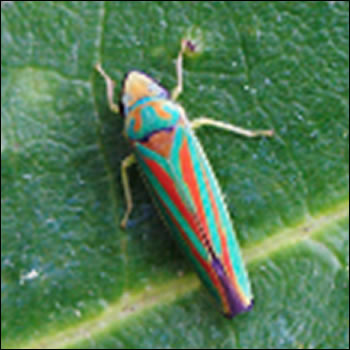RHODODENDRUM LEAFHOPPERS
Rhododendron leafhopper causes no direct damage, but they may spread a fungal disease known as bud blast that kills flower buds
There are several species of leafhopper that can be encountered by gardeners; they are sap sucking true bugs. Rhododendron leafhopper only feed on rhododendron/ azaleas. They are active on rhododendrons from late spring to autumn but are most noticeable when the brightly coloured bluish-green adults are present in late July - October.
Bud blast spoils developing flower buds, it is a fungal infection associated with the activities of the leafhopper. The nymphs of rhododendron leafhopper are creamy white wingless insects that live on the underside of rhododendron leaves. The adults are 8 - 9mm long and have pale yellow heads with a bluish green thorax. The wings are folded back along the body and are bluish-green with two orange stripes. The adults often rest on the upper surface of the foliage in sunny weather but readily leap off when disturbed. White cast skins shed by the nymphs may be seen attached to the underside of leaves.
The feeding activities of the adults and nymphs have no obvious adverse effect on the appearance of the foliage or the plant's vigour. There would not be a problem if the females did not make egg incisions in next year's flower buds in late summer-autumn. A fungal disease, known as bud blast (Seifertia azalea), may infect the buds through the egg wounds, although some recent research has placed doubt on this assumption. Infected flower buds turn brown and die

Control
There are no easy non-pesticide measures for the leafhopper. However, flower buds infected with bud blast can be picked off and disposed of to reduce the amount of fungal spores being released in the vicinity of the plants.